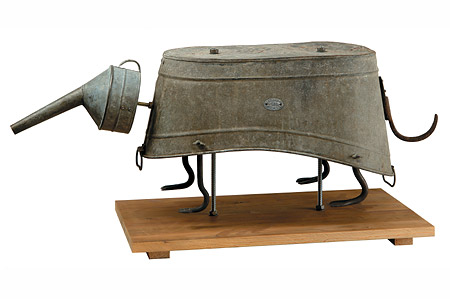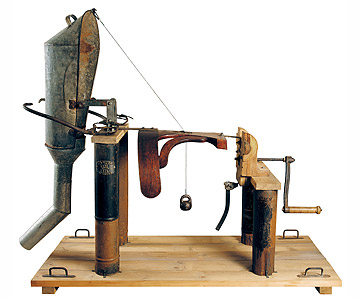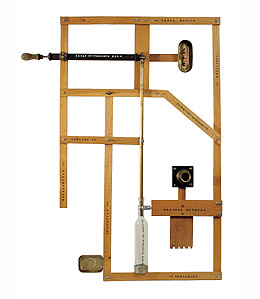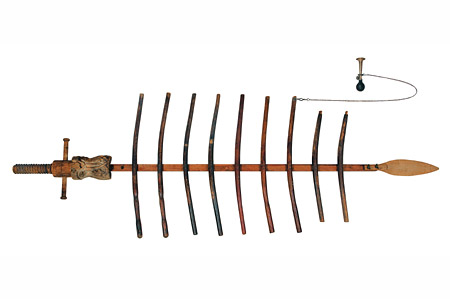 |
Olga and Alexander Florensky
The artists Alexander and Olga Florensky - headliners of numerous exhibitions, key members of the group Mit'ki - live in St. Petersburg and work at their country-house. Their works are kept in dozens of museums around the world. For over twenty years, they have been making impossible objects and other equally wonderful things. Their objects are incredibly organic coalescences of found objects of various kinds - sometimes ones that have lived at home for a long time, sometimes ones found on the trash heap, sometimes bought at an expensive antiques stores. Their sizeable - judging by the dacha-studio overcrowded with art - oeuvre exudes light irony and feeds on the observation of children's games and wishes, which have made themselves at home in the adults' heads and have no desire to leave. The optics of a game sheds light on much in that seriousness which cannot tolerate reflexivity or self-irony - for example, the seriousness of war and victory, power, or world religions. In their large projects, the Florenskys show objects, paintings, photographs, drawings, silk-screens, blueprints, films (a mix of animation, documentary, and feature films). They can do everything.
Alexander Evangely
|
 |
O&A Florensky were born in 1960.
In 1982 graduated from College of Art and Design named after Mukhina.
The MITKI art group founders (1985). Had an internship at the Institut des Hautes Etudes en Arts Plastiques (director: Pontus Hulten) (1990). Members of Art Union of Russia.
The authors of the animation movies: MITKIMAIER, 1992, The Story of a Miracle of Miracles (Olga Florenskaya, 1994) and Captured movies (O&A Florensky, 2004).
O&A Florensky are participants of Russian and International film festivals (1993-2005) and founders of MITKILIBRIS publishing house (1994).
Alexander Florensky - one of the founders and curator of MITKI-VHUTEMAS art center in St. Petersburg (1997-2005), in 2003-2004 - chief artist and curator of Adresa Peterburga magazine.
Since 2006 Alexander Florensky is the head of contemporary art department in Tsarskoselsky Collection State Museum.
Since 1994 O&A Florensky work together for big projects (Movement Towards Iye, Moveable Bestiary, Local Time, Russian Trophy, Russian Patent, Wilhelm Winter's Universal Museum, etc.).
In 2004 A. Florensky (together with I. Sotnikov) creates the Society of amateurs of painting and drawing.
Artists live and work in St Petersburg and Tbilisi.
|
|

Î&À Florensky. Armadillo Skeleton
From the project Various Skeletons, 2008
Object, mixed media, 50õ100õ45 cm
|
|

Î&À Florensky. Elephant Skeleton
From the project Various Skeletons, 2008
Chair back, casting mold, coal pan, tin pipes, climbing irons, three-pound weight,
145õ180õ65 cm
|
|

Î&À Florensky. Downtown Kronstad
From the project Geographical Maps, 2006
Straightedges, garden pump, inkstand, bottle, aluminum cans, toy boat, 110õ55 cm
|
|

Î&À Florensky. Beluga Skeleton
From the project Various Skeletons, 2008
Parts of Viennese chairs, wooden capital, screw for workbench clamp, swingle, chain, hooter, 260õ90õ15 cm
|
|
Alexander Florensky: About Olga's first project with objects, Ekaterina Andreeva wrote, "Pity and the desire to show a thing some kindness." Our dacha is like an installation made of those things, sometimes it's impassible. All of the rooms of an old two-story house, all of the sheds - everything is taken up by things that with time will turn into sculptures. After an exhibition, we have to figure out what to do with the objects. We have no problems with storage spaces, of course, but three-meter boats still interrupt the flow of our life. Every once in a while, we manage to get rid of them. Then we are happy.
Since there is no commerce, we work at our own pace, the way it happens of its own accord, try not to allow deadlines. Some things have been kept in the family probably for about 50 years, while others were bought yesterday at a flea market. Sometimes, it's the flea market and the trash heap and sometimes an antiques store, and not a cheap one at that. When it is necessary, everything gets used; just as you would not skimp on canvas and paint, so you don't skimp here. If it is necessary to pay a load of money, it immediately gets paid, so that on the one hand, it's "poor" art, and on the other, it's anything but. In our activities, there is a guileless joy derived from the fact that there is a circulation of things in a family, in nature. There is also the urban tradition - to send outmoded things to the dacha, and in our case, that is so, the dacha is our main studio. First, the things are sent to the dacha, and then they return, for example, to the collection of the Russian Museum or the Tretyakov Gallery; there is in this the joy of transformation. Because the next step for those things was going to be either the trash heap at the dacha or the bonfire, and yet suddenly, they now return victorious to the city - the things that got lucky.
|
 |
The inner force-fields of a work are completely invisible to an outsider (who often can't even understand what objects were used), while Olga and I know the entire history of an object. For example, Snake Skeleton - the main element there is a handle from a 1950s floor polisher. I can remember polishing the floor with mastic when I was little, my grandmother gave me that chore. The heavy part was used up about ten years ago in the project Russian Patent. The handle lay around for another 13 years and became the basis of an object - only Olga and I know this, but it's very important for me, just as in abstract painting, that which inspired the artist s important to him, even though it's not known to anyone else, but it's precisely that mystery which makes the thing living. And so it is here; I know - that's what is most important. One could write an essay about every object, every single one is put together out of something similarly special.
We need for things to coalesce as organically as if the object was created a hundred years ago and not by us. Moreover, there are the internal rules of the game; things are never painted or tinted. All of the joints are screw-based, there is no welding. If a thing fits perfectly in terms of design but does not fit in terms of color, then, alas, we are forced to look for a replacement. It's the endless role-casting of objects until they coalesce so organically that the object exists in only that way, despite its obvious absurdity and the extrinsic details one can note in it.
Our work is like a game of ping-pong - you can't play alone. You find pleasure in the process of the creation of these objects, especially when you have already figured out how to put one together, and the end is in sight.
|
|
SELECTED SOLO EXHIBITIONS
2008 Various skeletons. NOMI art gallery, St. Petersburg
Various skeletons. Gallery for Contemporary Art, Tromso, Norway
2007 Russian trophy. Retretti exhibition center, Finland
Postcards and Envelopes. Central Museum of History of Communication, St. Petersburg
2006 Geographic Maps. NOMI gallery, St. Petersburg
Russian Trophy. NCCA, Moscow
Russian Trophy. NCCA, Nizny Novgorod
Russian Trophy. State Russian Museum, St. Petersburg
Religious Buildings. M. Guelman Gallery, Moscow
2005 Views of Petersburg. Nabokov's museum, St Petersburg
Religious Building. Museum of the history of religion, St. Petersburg
2004 Taxidermies. Art center Annantalo, Helsinki
2002 Russian Trophy. Hand Print Workshop International, Washington, DC
2001 Moveable Bestiary. Centre for Contemporary Art, Ujyazdowsky Castle, Warsaw
2000 Movement Towards YIE. Anhava Gallery, Helsinki
Taxidermies. Modest Architecture. M. Guelman Gallery, Moscow
1999 Local Time (The Development of Chronometry in Russia. State Museum of the History of St Petersburg (in collaboration with Outi Heiskanen), St. Petersburg
1998 Moveable Bestiary in the Summer Garden. Summer Garden, St. Petersburg
Selected Material for the Project Moveable Bestiary. Josef Bakstein. Institute of Contemporary Art, Moscow
Russian Patent (in collaboration with G. Pellegrini). M. Guelman Gallery, Moscow
1996 IYE. Rauma Biennale, Finland
1995 Movement Towards IYE (the archive of I.P. Barinov). Borey Gallery, St Petersburg
1994 Russian Design. Borey Gallery, St. Petersburg
Russian Album. Borey Gallery, St Petersburg
Miscellany. Gallery 10/10, St Petersburg
|
 |
SELECTED GROUP EXHIBITIONS
2008 Russian Povera. Project by Sergey Gordeev. Curator - Marat Guelman. Rechnoi Vokzal, Perm
2007 Society of amateurs of painting and drawing: Georgian Landscapes. Carvasla gallery, Tbilisi
Artist's Diary. M. Guelman Gallery in the frames of 2 Moscow Biennale of contemporary art, Central House of Artist, Moscow
Thaw. M. Guelman Gallery 15th anniversary. State Russian Museum, St. Petersburg
Society of amateurs of painting and drawing: Landscapes. Borey art center, St. Petersburg
2006 Collage in Russian Art. State Russian Museum, St. Petersburg
Russische Souvenirs. Bielefeld, Germany
2005 Academy of Porcelain. St. Petersburg, State Hermitage
2004 Tamed and Wild. State Russian museum, St. Petersburg
Na Kurort! Kunsthalle, Baden-Baden, Germany
2003 The Return of Mir Iskusstva. St. Petersburg History Museum, St. Petersburg
ART-Moscow workshops. Art -Moscow Fair, Moscow
Graphic Art of XX Century. State Tretyakov Gallery, Moscow
Night Train Surrealist Routes to Kiasmas's Collections. KIASMA Museum, Helsinki
Typewriters. PRO ARTE, S.-Petersburg
2002 Moveable Bestiary and Other Objects. Architectural Association, London
Snegurochka. Zacheta National Gallery, Warsaw
FEMME ART O. Florenskaya. Art of feminine gender. State Tretyakov Gallery, Moscow
2001 Iskusstvo 2000. Kunstverein Rosenheim, Germany
Nordic Postmodernism. KIASMA Museum, Helsinki
Contemporary Art from St. Petersburg. Tallinn Art Museum, Tallinn
ART-Moscow workshops. Art -Moscow Fair, Moscow
2000 M. Guelman Gallery in the State Russian Museum. State Russian museum, St. Petersburg
Anatomical Person. Kunstkamera Museum, St Petersburg
Taxidermy. Modest Architecture. Moveable Bestiary. State Russian Museum, St Petersburg
Dynamic Couples. M. Guelman Gallery, Moscow
1999 Fauna. NCCA, Moscow; NCCA, Nizhny Novgorod; Zacheta National Gallery , Warsaw
1998 Exhibition of New Acquisitions. State Russian Museum, St Petersburg
1997 Movement Towards IYE. Centre for Contemporary Art, Ujyazdowsky Castle, Warsaw
Movement Towards IYE. Szczecin Biennale, Poland
Red in Russian Art. State Russian Museum, St Petersburg
5 Years of the Department of Contemporary Art. State Russian Museum, St Petersburg
1996 IYE. Rauma biennale, Finland
1994 For 10th anniversary of MITKI group. State Russian Museum, St Petersburg
|
 |
|
 |